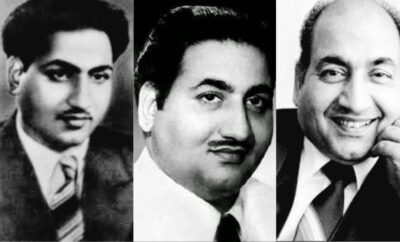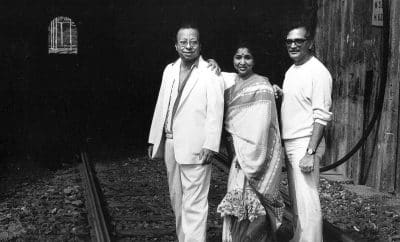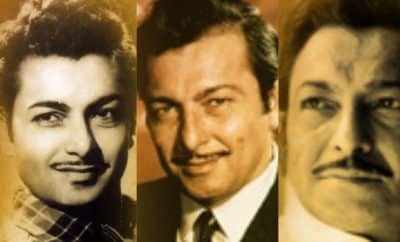Collections
When Gandhaar Meets Pancham…
Alongside the sunrise of independence on India’s horizon, a bright star in the form of a singer also rose in the firmament of Hindi cinema, who in almost no time went on to achieve an unswerving position like the Polaris. Albeit a newcomer, she rose to fame and swept the extant established singers aside in a trice.
A callow young boy had arrived at a recording studio to attend the recording of a Hindi song composed by his father, which the singer was going to sing. Quite inquisitive to see the singer and expectant of a colossal personality commensurate with the fame she had achieved, the boy was taken aback to see a lean young girl draped in a white saree without any make-up or ornamentation. When the boy entered the recording booth to observe the singer sing his father’s composition, he was bemused once again to see that she was just crooning the song. Pretty sure that this was not what his father expected, he immediately ran to his father who was conducting the recording, where he could hear her sharp yet honeyed rendition clearly. With a great deal of amazement, the boy asked his father how she could manage that. His father replied, “This is her power, my boy! She knows where exactly her voice should hit the mic; and this is what makes her what she is!” Perhaps at the very moment, the boy decided that his first song would be sung by none other than the singer, if he ever became a composer.
In around a decade’s time, the boy, who was now a zealous young chap brimming with music, got his first film as a composer. He remained true to his determination and used the singer’s voice in 4 out of 7 songs in his first soundtrack. Much before he signed the first film, his father and the singer had gotten into a feud and stopped working with each other. The boy was so steadfast on using the singer for his first soundtrack that keeping the ego aside, his father had to call the singer and ask if she would oblige by singing for his son. The singer also graciously acceded to the request and not only agreed to sing for the son’s first film, but also resumed the work with the father. The son went on to become a pathbreaking composer far ahead of his time, whose music continues to be loved even today. His association with the singer, that started with his first film, soon became a prolific musical alliance, and lasted till the composer’s last film.
Either the singer would dominate the composer’s soundtrack, or the composer would at least reserve a special song or two for her. Somewhat unhappy with this, the composer’s wife, who too was one of the established and the most versatile singers of Hindi cinema, complained to him about this. Very tactfully handling the “the devil and the deep blue sea” situation, the composer pacified his wife saying that she was like the all-rounder West Indies cricketer Garry Sobers and the singer was like the famous Australian batsman Don Bradman; and that it was fair on his part to use the good batsman for batting and the all-rounder player for anything.
It’s anyone’s guess! The composer is Rahul Dev Burman (fondly known as RD or Pancham), the son of the eminent golden era composer Sachin Dev Burman and husband of Asha Bhosle; and the singer was none other than Lata Mangeshkar, our beloved Lata Didi. The song at the recording of which Pancham first saw Lata Mangeshkar was “Thandi hawaayen, lehra ke aayen” from Naujawan (1951). The association between R.D. Burman and Lata Mangeshkar, that started with his first film Chhote Nawab (1961) ended only with his last film 1942 – A Love Story (1994).
As an infant, R.D. Burman would often cry in the fifth note (Pancham). S.D. Burman therefore started calling him as Pancham and the nickname became his identity. As per a belief in the discipline of Hindustani classical music, presence of ingenerate Gandhaar (the fourth note) in rendition is the acid test of the proficiency of a singer. It is said by the classical music experts that Lata Mangeshkar is bestowed with this innate Gandhaar (do we even need a proof?).
When the Gandhaar meets the Pancham, the confluence is sure to create miraculous musical gems. You would certainly agree with me, if I say that Lata Mangeshkar had a soft corner for the compositions of a few composers, and R.D. Burman was one of them for sure. This is evident from the a few extra drops of honey that she has added to his songs. Let us relish some of such gems jointly created by R.D. Burman and Lata Mangeshkar.
Ghar aa ja ghir aaye (Chhote Nawab – 1961)
Veteran actor and comedian Mehmood decided to turn producer with Chhote Nawab. He wanted S.D. Burman to compose the soundtrack. But as he was too busy to accommodate another film, Mehmood decided to sign his good friend R.D. Burman as the composer. Before Chhote Nawab, R.D. Burman was signed by Gurudutt for his film Raaz, which never saw the light of the day. Chhote Nawab thus became R.D. Burman’s first released film, and he proved his mettle in this very first film. The soundtrack has 7 songs of different types, ranging from a semi-classical composition “Ghar aaja ghir aaye” to a dance number with Arabian touch “Matwaali aankhon waale”.
“Ghar aaja ghir aaye”, based on raag Malgunji (rarely used in Hindi film songs), adorned by Lata Mangeshkar’s emotive rendition, swaying beats of tabla in Rupak taal (7/8 rhythm), sitar, sarangi and Shailendra’s brilliant lyrics (the only film in which R.D. Burman and Shailendra worked together) suiting the emotions of both the women on the screen, a courtesan (Sheila Vaaz) and a lovelorn girl (Ameeta), remains a celebrated song to date.
Kajre Badarwa Re (Pati Patni – 1966)
This is a pleasant romantic composition based on raag Piloo, expressing the yearning of a young girl (Nanda) for love, which gets intensified with the arrival of rains. The breezy melody is suitably adorned by the use of santoor, sitar and flute; and is beautifully rendered by Lata Mangeshkar adorably expressing the drizzling desire through her sweet voice. The lyrics are penned by Anand Bakshi.
Kya Jaanoon Sajan (Baharon Ke Sapne – 1967)
A dream sequence filmed on the lead actors Asha Parekh and Rajesh Khanna, this is one of the earliest miraculous experiments undertaken by the musical mastermind R.D. Burman. Though multitrack recording had already come into being, it had perhaps not arrived in Hindi film music by then. So, our magician used what is known as “the erase-head technic”. Erase-head erases the previous recording on a tape when one records again on that tape. R.D. Burman recorded the complete song in Lata Mangeshkar’s voice without the overlapping aalaps in the background. He then removed the erase-head played the same tape while recording only the aalaps in her voice. Thus, the aalaps got recorded with overlapping effect onto the original song, and the two-track-mixing effect was achieved. And the result became immortal! Initially, many people, who were unaware of the unimaginable experiment, though that the voice of Usha Mangeshkar, which resembles that of Lata Mangeshkar’s to a large extent, was used to achieve the effect.
Lata Mangeshkar’s haunting rendition takes the composition to an altogether different level. While she has rendered the whole song astoundingly, the way she picks up the refrain every time with the word “kya” remains inimitable. The lyrics were penned by Majrooh Sultanpuri.
“Aaja piya, tohe pyar doon”, another fantastic Lata solo from the film, also deserves a mention here.
Sharm Aati Hai Magar (Padosan – 1968)
The classic comedy film remains popular even among the current generation, not just for the hilarious performances by Mahmood, Kishore Kumar and Sunil Dutt, but also for its euphonious soundtrack composed by R.D. Burman.
While all the songs are superb, the romantic Lata solo “Sharm aati hai magar” remains an eternal personal favourite. After a lot of misunderstandings, Bindu (Saira Banu) understands Bhola’s (Sunil Dutt) true love for her. Surrendering to his love, she expresses her devotion through this melodious song.
The song is decorated with Rajinder Krishan’s suitable lyrics and the orchestration comprising the Burmans’ favourite instruments santoor, flute and sitar, besides sarangi, clarinet, and violins. Lata Mangeshkar’s rendition instantly makes you fall in love with the song. With all these elements coming together, the song looks like a beautiful Indian woman draped in an elegant saree and studded with glittering jewellery, just like Saira Banu looks on the screen. Her beauty makes it a visual treat too.
“Bhai battur, bhai battur, ab jayege kitni door?” is another noteworthy frolicky Lata solo from this soundtrack.
Kisliye Maine Pyaar Kiya? (The Train – 1970)
Expressing the eager wait outlined with a bit of insecurity by the innocent Nanda for her lover, this is yet another endearing song by the duo. R.D. Burman’s melodious composition with Lata Mangeshkar’s cloying rendition makes you feel that you can never have enough of that sweetness. Her consonance with the orchestration, and the percussion in particular, is astonishing. Beautiful Nanda emotes Anand Bakshi’s words very effectively.
Raina Beeti Jaaye (Amar Prem – 1972)
This is undoubtedly one of the best songs of Lata Mangeshkar and R.D. Burman. He has seamlessly used a blend of two raags in this song, viz. Todi and the favourite raag of the Burmans, Khamaj. The song starts taking the control of our heart right from the touching piece of sarangi at the beginning and Lata Mangeshkar’s deep aalaap with subtle pieces of santur fluttering around it. Then follows the prelude comprising flute played by Pt. Hariprasad Chaurasia accompanied by rhythm with haunting guitar chords. Then Lata Mangeshkar starts with her soulful rendition and the song starts like a deep river flowing gradually but gracefully. And when it ends, you realise that you have flown with it far away and are in no mood to return.
As the song is classical based, the orchestration comprises sarangi, santur, flute, dilruba and tabla. But then you hear guitar making its presence felt clearly, yet it does not look “odd man out” in the group of all the classical instruments. This is the R.D. Burman stamp! Different rhythmic patterns of taal Keherwa used in mukhdaa and the antaraa, with mild touches of maadal in mukhda also keep on announcing that this is an R.D. Burman song.
Baahon Mein Chale Aao (Anamika – 1972)
This brilliant composition continues to be an epitome of romance and soft expression of love even after 5 decades of its creation! R.D. Burman’s lovely composition is brought to life by Lata Mangeshkar through her playful and saccharine rendition. As the heroine (Jaya Bhaduri) is wooing Sanjeev Kumar very late in the night, she is expressing her feelings very gently. To suit this situation, Lata Mangeshkar has crooned the song quite softly. Yet her rendition sounds powerful and mellifluous while simultaneously creating the desired effect. This clearly calls for tremendous control over your voice. This could be one of the best examples of ideal playback singing. Few singers can imitate her rendition, particularly the consistency that she retains every time she sings “Baahon mein chale aao”.
Fantastic use of guitar is another notable feature of this song. Majrooh Sultanpuri’s apposite lyrics portray the romance in a simplistic style, as compared to his usual unique style.
Aaj Kal Paaon Zameen Par Nahin Padte Mere (Ghar – 1978)
This Lata solo is an expression of joie de vivre of a recently married young girl. With all the happiness that has fallen into her lap after her marriage, she is on cloud nine, and hence is not able to rest her feet on the ground. R.D. Burman has composed a soft, yet exuberant tune decorated with sitar, violins, flute and mandolin. Lata Mangeshkar has done complete justice to the song and sounds as sweet and fresh as she sounds in her first song with R.D. Burman.
This is a good example of how the word wizard Gulzar creates magical lyrics out of simple words.
Another Lata song from Ghar, “Tere bina jiya jaaye na”, which is actually a Lata – Kishore duet in the film is also an outstanding composition by R.D. Burman, marked by the superb use of Madal Tarang.
Rimjhim Gire Sawan (Manzil – 1979)
This gleeful and frisky composition remains overshadowed by its twin composition, i.e., the extremely popular Kishore Kumar version of this song. Lata Mangeshkar has sung R.D. Burman’s fast paced composition comprising mainly of violins and guitar with a lot of effervescence, perfectly expressing the feelings of a girl who has just fallen in love. Yogesh’s words aptly support this expression too.
Tune O Rangeele Kaisa Jadoo Kiya? (Kudrat – 1981)
This is another sweet expression of feelings of happiness and revelations of a girl who has just fallen in love. R.D. Burman’s composition overflowing with romance and Lata Mangeshkar’s pleasant rendition make us tap the feet and nod the head al through. At just 52(!), Lata Mangeshkar’s young voice seems like dancing with the composition while expressing the joy. The song is penned by Majrooh Sultanpuri.
Kuchh Na Kaho (1942, A Love Story – 1994)
Lata Mangeshkar’s last song for R.D. Burman for his last film, the sad tandem version of the popular romantic song sung by Kumar Sanu, is an intense expression of agony and distress. It portrays the feelings of a young girl, whose lover is about to be hanged for his participation in the freedom fight. The lyrics are written by Javed Akhtar.
As Lata Mangeshkar has said in an interview, when R.D. Burman called her for this song, she was in Delhi and agreed to record it as soon as she was back. However, unfortunately, R.D. Burman had breathed his last by the time she was back; and she recorded the song after his demise, as per his wish.
https://www.youtube.com/watch?v=YH4VH4TOO4c
And there are many more! One feels like a kid in a candy store while exploring their sugary repertoire. While both the hands are full of candies, the craving for more does not end!




Suguna Kannan
September 28, 2021 at 10:10 am
A very comprehensive description of a great association between two towering personalities. Yogesh’s love and admiration for them is very evident in his article!
Yogesh
September 28, 2021 at 7:53 pm
Thanks a lot, Suguna ji